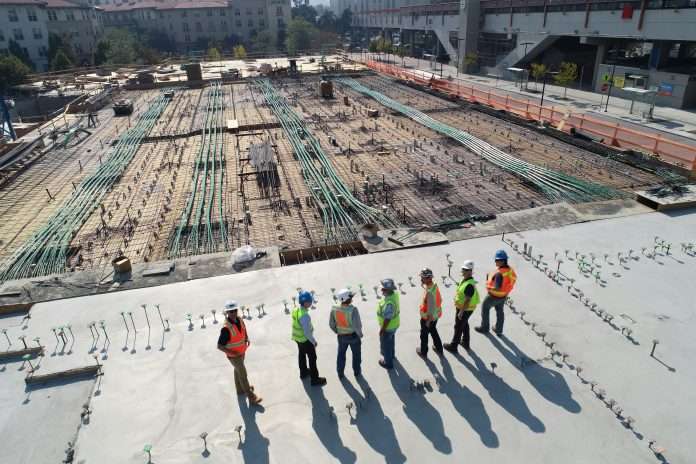After two years of EU Taxonomy reporting, Greenomy’s Sustainability and ESG data experts have embarked on an in-depth review, focusing specifically on the construction and real estate sectors. This first sectoral analysis aims to illuminate the practical application of the EU Taxonomy, guiding companies towards the goal of carbon neutrality by 2050.
By examining these sectors, Greenomy uncovers crucial insights into their alignment with sustainability objectives and their contribution to environmental goals.
The construction and real estate sectors, instrumental in the global effort to reduce CO2 emissions, are under the microscope for their significant potential impact on climate change. Accounting for around 40% of global CO2 emissions, their alignment with the EU Taxonomy not only influences their operational footprint but also sets a precedent for other industries. Greenomy’s analysis seeks to compare their performance against other sectors, highlighting both achievements and areas needing improvement. The ESG FinTech company has outlined nine key findings from its analysis.
State of alignment
Its research reveals that the real estate sector boasts the highest EU Taxonomy eligibility rate amongst all sectors, with an impressive 87% of turnover deemed eligible. The construction sector follows closely, showcasing a commendable effort towards sustainability with a 47% eligibility rate. These figures not only reflect the sectors’ commitment to aligning with the EU Taxonomy but also highlight their potential for attracting sustainable financing options, a crucial advantage in today’s economy.
Implications of eligibility and alignment scores
The high eligibility score in these sectors not only reflects their substantial contribution to sustainability but also influences their access to financing. Companies with high alignment levels are more likely to attract favorable financing options, highlighting the financial benefits of sustainable practices. However, the distinction between sustainable and less sustainable companies could pose reputational risks for the latter.
Most frequently selected activities
Delving deeper, Greenomy explores the most frequently selected activities within these sectors, shedding light on their compliance strategies and pinpointing where they excel and falter. The top three activities are acquisition and ownership of buildings, constrution of new buildings and renovation of existing buildings.
What’s new?
Until 2023, only activities with a substantial contribution towards climate change mitigation and adaption objectives could be selected. In Greenomy’s report, only 5% of the construction companies reported some eligibility towards the climate change adaption objective.
However, from 2024, the four new environmental objectives can be selected. Among these, only the circular economy objective has led to the creation of new activities directly linked to the construction & real estate sectors.
Focus on the top 3 activities
Non-Alignment with substantial contribution criteria
For the “Construction of New Buildings” activity, companies are required to ensure their projects’ Primary Energy Demand (PED) is at least 10% lower than the Nearly Zero-Energy Buildings (NZEB) benchmark to significantly contribute to climate change mitigation (CCM) objectives. The main hurdles to alignment include inadequate energy performance, with some buildings not receiving PED assessments or failing to meet the NZEB’s 10% reduction requirement. Notably, the absence of Global Warming Potential (GWP) calculations also led to non-compliance for some firms.
In the “Renovation of Existing Buildings,” compliance details are less clear, yet companies must either meet local major renovation standards or show a PED reduction of at least 30%. Often, firms not meeting these criteria redirected investments towards energy efficiency improvements. However, this highlights a broader challenge in achieving compliance through direct renovation efforts.
The “Acquisition and Ownership of Buildings” activity demands buildings have either an Energy Performance Certificate (EPC) of class A or a PED within the top 15% of regional standards for substantial contribution. Most non-compliance issues stem from failing the first criterion, prompting companies to opt for the relatively simpler 15% benchmark. However, this approach’s effectiveness varies, with some regions providing clear benchmarks, while others require companies to rely on alternative data sources for compliance evidence.
Non-alignment with Do No Significant Harm (DNSH) criteria
For construction and renovation activities, the reasons behind non-compliance with the Do No Significant Harm (DNSH) criteria are diverse, indicating a need for clearer guidance within the sector. These criteria encompass a range of environmental considerations, including Climate Risk Assessment, water usage, waste management, pollution prevention, and biodiversity preservation.
Notably, the greatest challenge for compliance often lies in meeting the circular economy requirements, particularly the target for 70% of waste to be prepared for reuse, recycling, and recovery. Additionally, difficulties in controlling the use of hazardous substances and managing tasks that are time-consuming contribute to non-compliance, with the criteria for water use and biodiversity posing fewer obstacles, except in cases involving buildings outside the EU, where adhering to European standards becomes more complex.
In contrast, for the activity of acquiring and owning buildings, the primary DNSH criterion revolves around Climate Risk Assessment. Here, companies face inconsistencies in alignment, largely due to ambiguous guidelines on conducting assessments and determining acceptable risk levels. This discrepancy highlights the sector’s struggle with implementing a uniform standard for climate risk, further complicating the path towards full DNSH criteria compliance.
Non-alignment with minimum social safeguards criteria
Other pain points
Several practical challenges, such as the influence on project design and the variability in national and regional regulations, hinder companies’ ability to fully align with the EU Taxonomy. Overcoming these obstacles is essential for achieving broader compliance.
Greenomy emerges as a crucial ally for companies in the construction and real estate sectors, offering tailored solutions to streamline CSRD/EU Taxonomy reporting. Our platform provides essential research, best practices, and the tools needed to achieve and demonstrate alignment with the EU Taxonomy, facilitating a smoother transition to green operations.
Read the full story here.
Keep up with all the latest FinTech news here.
Copyright © 2024 FinTech Global











